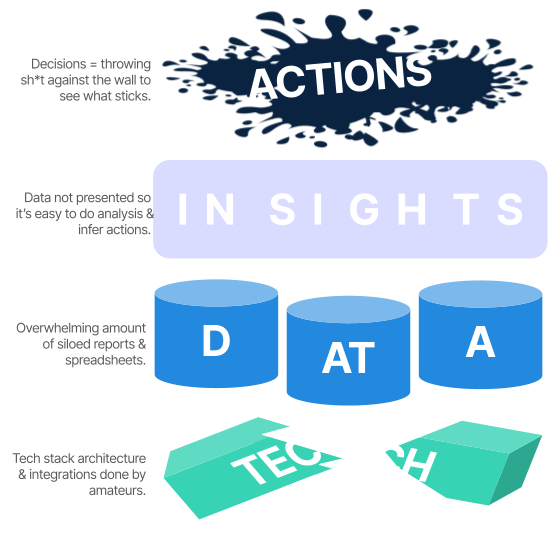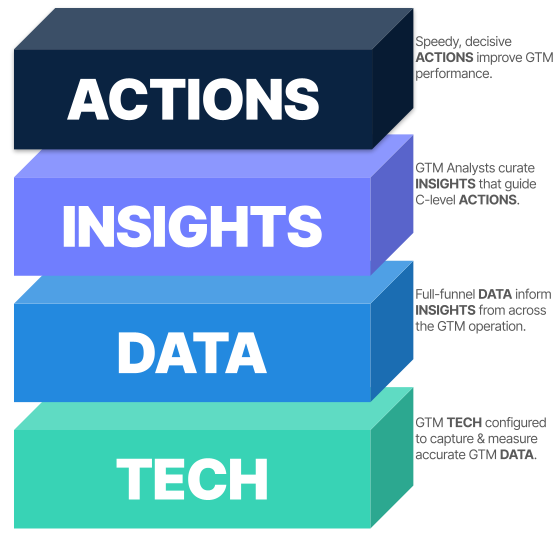GTM DATA STRATEGY FRAMEWORK
DATA DRIVES ACTION
This strategic framework transforms your data posture from passive GTM reporting → actionable GTM insights that answer the questions your senior executives need to drive performance improvements.
→ Compare Passive vs. Actionable GTM Data Posture
Passive GTM Reporting

Actionable GTM Insights

What is Data Drives Action Framework?
scaleMatters' Data Drives Action Framework is a methodology to transform your Go-to-Market (GTM) data infrastructure so it becomes a legitimate tool that helps leaders properly answer the right questions that will lead them to take actions that drive performance forward.
The framework is designed to answer four fundamental questions:
- What are all the possible actions we could take that might improve our performance?
- What are all the questions we must be able to answer that would compel us to execute one set of these actions over another?
- What data do we need and how should it be presented help us easily answer these questions.
- How do we need to reconfigure our GTM tech stack and what processes need to be introduced / changed to ensure that we capture that data and maintain data hygiene?
The Purpose of Data Drives Action Framework: Answer Executive Questions
The decisions senior executives make and subsequent actions we take have a real impact on company performance.
As leaders, it is imperative that we ask, and be able to answer the right questions in order to make the best decisions and take the most productive actions to improve performance.
It is not good enough to simply know that your LTV / CAC stands at 4.2.
You need to be able to answer the question: "How will you get the LTV / CAC to 6.0?"
And to answer that question, there are all sorts of additional questions you must be able to answer.
- Why is our logo retention declining...is it systemic, or specific to certain account managers or industry verticals?
- Where is the biggest leakage point in our new logo acquisition process...is that systemic or related to certain sourcing verticals?
- Which of my channels have the best/worst ROI so I can double down on the good ones?
- What is the expected outcome if we increase investment in a specific area?
- What steps can we take to shorten the sales cycle?
And so on...
Without high integrity data, presented in a way that answers those questions (and others like them), we are left to guess and rely on intuition.
The purpose of the framework is to solve nagging GTM data quality issues and fill the GTM analytics and insights gap so that companies can actually answer those questions..
By answering those questions and taking rapid, informed action, companies can meaningfully change the trajectory of their performance...not just report on their performance.
Passive GTM Reporting vs. Actionable GTM Insights

Old Way: Passively Reporting on Performance
We refer to current state GTM analytics at most growth stage and mid-market organizations as Passive Reporting (but it could also be called Reactive Reporting.) This is what it looks like:
1. Broken Tech

Most of these businesses have not really instrumented their environment to produce the necessary data to answer these questions. The tech is often poorly configured because it was set up by people who are not experts in tech. Processes often don’t exist which would otherwise cause necessary information to be captured.
2. Siloed Data

The data is often siloed between sales, marketing and CS making it difficult to get a holistic picture of what’s going on. This is often the result of no senior executive “owning” responsibility for data across the entire customer journey which is one of the reasons we’re seeing more and more Boards put that responsibility on the CFO or COO. On top of that, most of these businesses are plagued with data hygiene issues which completely undermines the value of any analytics.
3. Unclear Insights

Thirdly, while these companies have hundreds of reports and dashboards, they’ve rarely been designed in a way that makes it easy to draw insights from so companies talk all the time about having a ton of data, but none of it is actionable.
4. Scattered Actions

As a result, senior leaders are left to act on gut and intuition and even the most experienced of us won’t always get it right and our actions often make the situation worse because of unintended consequences.
New Way: Designing for Actionability
This framework for achieving actionable data is super effective, because by starting with the end outcome which is performance improving actions and reverse engineering back to the tech and processes we ensure a complete linkage that creates actionable data.
1. Prioritize Likely Highest Impact Actions

We start by considering the outcome…which is the set of all possible actions one might take to improve GTM performance.
Clearly, there are dozens if not hundreds of actions one can take but we have synthesized them into a handful of categories or buckets of actions. For example you might take actions to change people…such as coaching, training or even terminating. You might take actions to streamline processes with the goal of shortening sales cycles or perhaps improving conversion rates. You might decide to change channels perhaps by reallocating investment away from one channel such as outbound prospecting in favor of another such as paid LinkedIn advertising. And so on.
2. Identify Required Insights and Questions To Be Answered

By knowing the possible actions one might take, we then ask ourselves what Insights do I need to have that would compel me to take one action over another.
Said another way, what questions do I need to be able to answer to inform actions. Identifying these key business questions is a critical part of the methodology. In product development vernacular, you can think of the business questions as the requirements that need to be met with the design of our data and analytics.
3. Identify Charts, Tables, and Data that Provide Insights / Answer Questions

The next step after identifying the insights or key business questions is to translate that into what data is needed and how does it need to be presented in order to readily answer those key business questions.
4. Identify Tech and Process Changes Needed to Capture Data

And then the final step in the methodology is to identify how that data is going to be sourced through a combination of instrumenting the tech and implementing processes which capture the necessary data.
Example of Data Drives Action
Let’s parse this a bit deeper with a specific example of how it works. Remember we start by identifying the possible actions that can be taken to improve performance.
In this example, we’re going to consider actions to change channels. When we say channels we are referring to the channels or strategies a company uses to source prospective customers.
Channels might include things like paid search advertising, paid LinkedIn advertising, outbound SDR prospecting, events and trade shows, community sponsorships as well as say channel partners.
And when we talk about actions to change channels we would most likely be talking about increasing or decreasing investment in certain channels so that we are more heavily investing in our most productive channels and moving investment away from the least productive channels.

So what insights would we need that would compel us to move money into one channel and take money away from another?
Well, we would need to know relative ROI on a channel basis assuming that efficiency was the priority. If growth was the priority we would need to know which channels were most scalable and had the greatest upside. If we prioritized a balanced efficient growth strategy then we would want to know which channels were the most scalable and efficient. Or perhaps we were focused simply on maximizing near-term results in which case we would need to know which channel mix would in fact accomplish that. As I mentioned before, this is a critical part of the methodology because it sets the stage for the instrumentation and analytics.
By being crystal clear on these questions that you need to be able to answer, it makes it fairly straight forward to define what data is needed and how should it be presented to most easily answer the questions.

The presentation or design of how the data is reported is critical. This is what makes it easy to draw insights from data.
As an example, here is a dashboard which is designed to help answer the very specific question of What channels have the best ROI?
 Though it might be difficult to see here, the data is organized to look at relative value of an opportunity by channel as well as relative value of a lead by channel. Combined with the other charts on this dashboard it makes it really easy for the revenue leader or analyst to draw conclusions about relative channel ROI and take actions to double down on the good ones and terminate investment in the non-productive channels.
Though it might be difficult to see here, the data is organized to look at relative value of an opportunity by channel as well as relative value of a lead by channel. Combined with the other charts on this dashboard it makes it really easy for the revenue leader or analyst to draw conclusions about relative channel ROI and take actions to double down on the good ones and terminate investment in the non-productive channels.
So let’s go back to the required data to answer the questions. We need full-funnel analytics to answer ROI and scalability questions. This includes volume metrics, conversion rate metrics as well as cycle time metrics. Here is an example of full-funnel analytics by channel.

We need cost data and that we need to be able to attribute costs to different parts of the funnel for each channel. And we need NRR data attributed by channel.
So now we’ve identified the data we need as well as how it should be presented to improve actionability. And by the way, up to this point this work can be done by the leadership team and or GTM analyst.

The last step then is determining how we are going to source that data and ensure sufficient hygiene so the data is worth analyzing. And this is where a GTM analyst teamed with GTM technology architect are required to put the meat on the bones.
It’s during this stage of the methodology that you will need to get very detailed about what objects, fields, layouts and automations in the CRM need to be touched and how.
You’ll also need to be clear on specific integrations between the CRM and other tech that are necessary to produce the required data, including how to ingest the necessary cost data from the financial systems. And it’s during this stage where you may need to implement new processes to ensure proper data capture.
For example we recently helped a customer implement a deal certification process where finance had responsibility for moving opportunities to closed Won. This process change immediately fixed the problem of inconsistent data between CRM and ERP. Again, this methodology has been proven effective across a number of organizations and it is effective because it is undeniable in how it connects data to actions.
Case Study: $40M Customer Success Platform
This stuff works. When you get your GTM data to a state of true actionability performance will definitely improve. Take the case of a $40M SaaS provider of customer success platforms.
They were experiencing a significant decrease in win rate. They thought it was due to an overall softening of macro conditions combined with the fact that their newer sales cohorts were really struggling. They considered terminating the new sales cohorts and battening down the hatches on expenses in general.
After working with them to get their GTM data and analytics in a better state, it became apparent that the primary cause of the declining win rate was that marketing had recently started over indexing on SMB leads, those SMB leads were outside of ICP and converted much more poorly than non-SMB and the newer sales cohorts were disproportionately handed the SMB leads to work.
As a result, the company redirected its top-of-funnel investments back to ICP targets and the win rate doubled within 2 quarters. Now just imagine if you were able to double your win rate. What that does to growth and valuation.
Case Study: $15M SMB Marketing Platform
Here is another example of how solid GTM operational analytics can have a major impact on outcomes. This company is a $15M SaaS provider of a marketing platform for local businesses like roofing companies and home services companies.
They had started experimenting with Facebook advertising and saw a terrific correlation between spend and leads. They thought they had finally found a scalable sourcing strategy and began to double down on the Facebook Ad spend and pull their SDRs off of prospecting in order to service the rapidly increasing number of leads coming from Facebook.
But while their leads were going up their bookings were in fact decreasing.
Here again by helping them get their data into a better state of actionability, what the data actually showed was that SDR Prospecting was a much more productive channel for them than Facebook Advertising because the Facebook leads converted so poorly. In fact, the data showed that it cost them $22K to acquire a customer via Facebook Ads vs. $5K to acquire a customer through traditional SDR cold calling…a difference of more than 4X. And part of the reason was they were applying expensive SDR and AE resources on working these poor converting leads.
So they redirected their efforts toward prospecting and away from Facebook and literally, within 4 months, their bookings were up 6X.
Apply Data Drives Action Framework at Your Company

Data Drives Action Framework Template
This LucidChart template will show you how to employ the logic of the Data Drives Action Framework within your own organization to transform your data into a useful management tool. Designing a solid GTM data strategy and infrastructure is a complex and daunting undertaking. This framework is an efficient, effective way to achieve best-in-class GTM data strategy and infrastructure so you can answer the right executive questions that improve performance.

GTM Reporting Health Check
Take scaleMatters' GTM Reporting Health Check 🩺 to learn how your company compares to best practice GTM reporting and learn how you can quickly improve your reporting to drive better GTM outcomes.
Get in Touch with scaleMatters
Reach out to learn how we can help you can get actionable GTM data, reporting, and insights in under 90 days.




